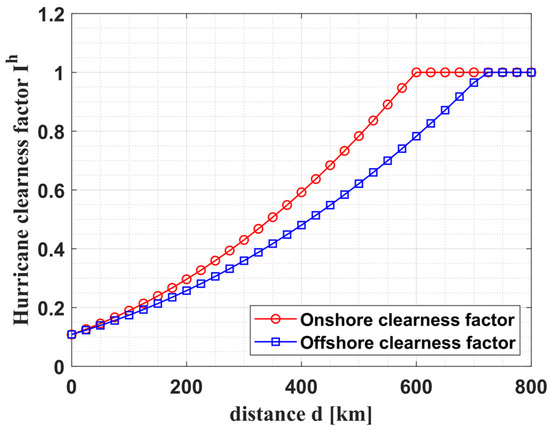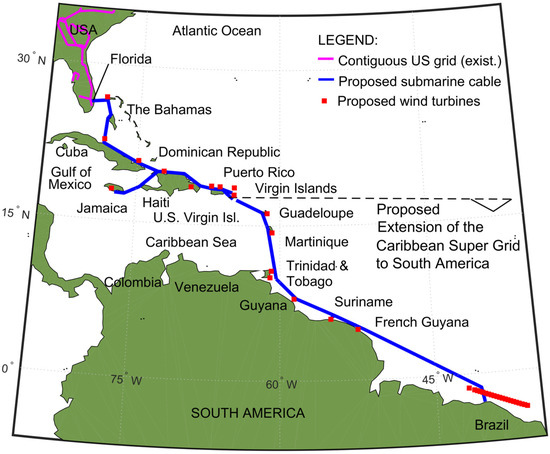2024-04-24 オークリッジ国立研究所(ORNL)
<関連情報>
- https://www.ornl.gov/news/study-shows-potential-super-grids-when-hurricanes-overshadow-solar-panels
- https://www.mdpi.com/1996-1073/17/7/1545
- https://www.mdpi.com/1996-1073/17/1/233
- https://www.sciencedirect.com/science/article/abs/pii/S1364032122009637
米国-カリブ海-南米スーパーグリッド計画における時空間太陽光発電プロファイルのハリケーン下での推定方法 Method for Spatiotemporal Solar Power Profile Estimation for a Proposed U.S.–Caribbean–South America Super Grid under Hurricanes
Rodney Itiki,Nils Stenvig,Teja Kuruganti and Silvio Giuseppe Di Santo
Energies Published: 23 March 2024
DOI:https://doi.org/10.3390/en17071545

Abstract
Solar photovoltaic (PV) generation technology stands out as a scalable and cost-effective solution to enable the transition toward decarbonization. However, PV solar output, beyond the daily solar irradiance variability and unavailability during nights, is very sensitive to weather events like hurricanes. Hurricanes nucleate massive amounts of clouds around their centers, shading hundreds of kilometers in their path, reducing PV power output. This research proposes a spatiotemporal method, implemented in MATLAB R2023b coding, to estimate the shading effect of hurricanes over a wide distribution of PV solar plants connected to a high-voltage power infrastructure called the U.S.–Caribbean–South America super grid. The complete interconnection of the U.S., the Caribbean, and South America results in the lowest power valley levels, i.e., an overall percentual reduction in PV power output caused by hurricane shading. The simulations assess the impact of hurricanes in 10 synthetic trajectories spanning from Texas to Florida. The Caribbean would also experience lower power valleys with expanded interconnectivity schemes. The U.S.–Caribbean–South America super grid reduces Caribbean variability from 37.8% to 8.9% in the case study. The proposed spatiotemporal method for PV power profile estimation is a valuable tool for future solar power generation expansion, transmission planning, and system design considering the impact of hurricanes.
米国-カリブ海スーパーグリッドの南米への拡張によるハリケーン時の耐障害性の提案 Proposed Extension of the U.S.–Caribbean Super Grid to South America for Resilience during Hurricanes
Rodney Itiki,Madhav Manjrekar and Silvio Giuseppe Di Santo
Energies Published: 1 January 2024
DOI:https://doi.org/10.3390/en17010233

Abstract
Climate change mitigation, adaptation to intensifying hurricanes, and decarbonization challenges in developing countries emphasize the urgent need for resilient high-voltage grids to facilitate the expansion of renewables. This research explores the technical feasibility of extending the U.S.–Caribbean Super Grid to include the Virgin Islands, Guadeloupe, Martinique, Trinidad and Tobago, Guyana, Suriname, French Guyana, and the northeastern part of Brazil in South America. This proposed extension aims to capitalize on the recent introduction of a new generation of wind turbines certified for operation under strong hurricane forces. The research utilizes modeling and simulation techniques to evaluate the performance of the proposed extension. A method for modeling and estimating spatiotemporal wind power profiles is applied, and the results demonstrate a reduction in maximum wind power variability within the U.S.–Caribbean Super Grid. Depending on the hurricane trajectory, the variability is reduced from 56.6% to less than 43.2%. This reduction takes effect by distributing peak surplus wind power alongside the proposed U.S.–Caribbean–South America Super Grid (UCASG). The research concludes by acknowledging the merits and limitations of the study and discussing potential directions for future research in this field.
ハリケーン下における風力発電の時空間プロファイルの方法: 米国-カリブ海スーパーグリッドの提案 Method for spatiotemporal wind power generation profile under hurricanes: U.S.-Caribbean super grid proposition
Rodney Itiki, Madhav Manjrekar, Silvio Giuseppe Di Santo, Cinthia Itiki
Renewable and Sustainable Energy Reviews Available online: 30 November 2022
DOI:https://doi.org/10.1016/j.rser.2022.113082
Highlights
- The method estimates the spatiotemporal effect of hurricanes on the wind power profile.
- The method proposes parabolic hurricane trajectories from the Caribbean to North America.
- Super grid connects Bahamas, Cuba, Haiti, Jamaica, Dominican Republic, Puerto Rico, and the Virgin Islands.
- The Caribbean super grid is simulated under hurricanes.
- The method is useful for power system planning, design, simulation, and operation.
Abstract
Wind turbines hit by hurricanes produce high variability of power generation profile. This research proposes a method to estimate this variability and solutions to smooth it. The method calculates the hurricane wind-speed profile in each turbine by Holland’s parametric equation in spatiotemporal steps of the hurricane trajectory. The calculated wind speed profile is converted into a power generation profile using wind turbine characteristic curves. Since the simulations show high variability of power profile, this research investigates two strategies to smooth such variability. The first one is systemic. A U.S.-Caribbean super grid interconnecting the Caribbean islands with the U.S. power grid by submarine high voltage direct current (HVDC) cables is proposed. This super grid shows technical feasibility since the proposed route of cables meets some installation criteria, such as a maximum water depth of 3 km and cable length not exceeding 879 km. The U.S.-Caribbean super grid reduces power profile variability by draining the wind power peak caused by hurricanes passing through the Caribbeans and transmitting it to the US power grid by the Florida-Bahamas HVDC interconnector. Another strategy, with special turbines, was tested to evaluate a potential reduction in power variability. However, the special turbines with a high cutout speed showed a limited effect on reducing the variability compared to the U.S.-Caribbean super grid. The proposed power profile estimation method is an essential tool for planning, preliminary design, and reinforcements of high voltage grids in hurricane-prone regions with wind power capacity.
Graphical abstract




